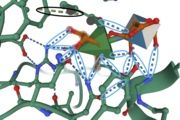Sandbox Reserved 1692
From Proteopedia
(Difference between revisions)
| Line 10: | Line 10: | ||
Gum Arabic (GA) is a representative protein of the family of arabinogalactan proteins (AGPs) and is produced in acacia trees in response to stress conditions, such as drought or wounds. GA has a variety of applications within the industrial world, including the food, cosmetic, and pharmaceutical industries, acting specifically as an emulsion stabilizer, emulsifier, and thickener in pharmaceutical settings. However, the the detailed structure of GA has not determined because of the complex branching that occurs in the polysaccharide. Enzymes that can react with and eliminate glycosidic linkages of carbohydrates are useful for determining the structure and function of these carbohydrates, giving researchers the opportunity to modify their physical properties. To date, there are no enzymes that have completely degraded GA <ref name="Kondo" />. | Gum Arabic (GA) is a representative protein of the family of arabinogalactan proteins (AGPs) and is produced in acacia trees in response to stress conditions, such as drought or wounds. GA has a variety of applications within the industrial world, including the food, cosmetic, and pharmaceutical industries, acting specifically as an emulsion stabilizer, emulsifier, and thickener in pharmaceutical settings. However, the the detailed structure of GA has not determined because of the complex branching that occurs in the polysaccharide. Enzymes that can react with and eliminate glycosidic linkages of carbohydrates are useful for determining the structure and function of these carbohydrates, giving researchers the opportunity to modify their physical properties. To date, there are no enzymes that have completely degraded GA <ref name="Kondo" />. | ||
== Important amino acids== | == Important amino acids== | ||
| - | Amino Acids <scene name='89/892735/Amino_acids2/2'>His85, Asp106, Tyr150, Ser170, Tyr202, Arg220, Pro223, Ala225, and Arg331</scene> provide important interactions for binding in the active site. The amino acid residue <scene name='89/892735/His85interactions/1'>His85</scene> is located near the C-5 atom of Rha, suggesting it has a catalytic role as a proton acceptor within the active site. The <scene name='89/892735/His85_and_his105/1'>His105 side chain forms a hydrogen bond with His85</scene> side chain, providing stabilizing assistance. Amino Acid Residues <scene name='89/892735/Tyr150_and_his85/1'>Tyr150 and His85</scene> form a hydrogen bond with the O-1 atom of Rha, suggesting these residues play a catalytic role for the elimination reaction. <scene name='89/892735/O2o3hbonds/1'>Tyr26, Asn275, Gln276, and Arg331</scene> form hydrogen bonds with O-2 and O-3 atoms of Rha, providing further stabilization within the active site <ref name="Kondo">PMID:34303708</ref>.[[Image:IntermolforcesBIOCHEM.png|thumb]] | + | Amino Acids <scene name='89/892735/Amino_acids2/2'>His85, Asp106, Tyr150, Ser170, Tyr202, Arg220, Pro223, Ala225, and Arg331</scene> provide important interactions for binding in the active site. The amino acid residue <scene name='89/892735/His85interactions/1'>His85</scene> is located near the C-5 atom of Rha, suggesting it has a catalytic role as a proton acceptor within the active site. The <scene name='89/892735/His85_and_his105/1'>His105 side chain forms a hydrogen bond with His85</scene> side chain, providing further stabilizing assistance. Amino Acid Residues <scene name='89/892735/Tyr150_and_his85/1'>Tyr150 and His85</scene> form a hydrogen bond with the O-1 atom of Rha, suggesting these residues play a catalytic role for the elimination reaction. <scene name='89/892735/O2o3hbonds/1'>Tyr26, Asn275, Gln276, and Arg331</scene> form hydrogen bonds with O-2 and O-3 atoms of Rha, providing further stabilization within the active site <ref name="Kondo">PMID:34303708</ref>.[[Image:IntermolforcesBIOCHEM.png|thumb]] |
The image to the right shows important amino acids in the active site. Hydrogen bonding and pi-stacking interactions are indicated by the blue and black circles, respectively. | The image to the right shows important amino acids in the active site. Hydrogen bonding and pi-stacking interactions are indicated by the blue and black circles, respectively. | ||
== Structural highlights == | == Structural highlights == | ||
Revision as of 21:42, 8 December 2021
| This Sandbox is Reserved from 10/01/2021 through 01/01//2022 for use in Biochemistry taught by Bonnie Hall at Grand View University, Des Moines, USA. This reservation includes Sandbox Reserved 1690 through Sandbox Reserved 1699. |
To get started:
More help: Help:Editing |
Structure and Function of FoRham1
| |||||||||||
References
- ↑ 1.0 1.1 1.2 Kondo T, Kichijo M, Maruta A, Nakaya M, Takenaka S, Arakawa T, Fushinobu S, Sakamoto T. Structural and functional analysis of gum arabic l-rhamnose-alpha-1,4-d-glucuronate lyase establishes a novel polysaccharide lyase family. J Biol Chem. 2021 Jul 22:101001. doi: 10.1016/j.jbc.2021.101001. PMID:34303708 doi:http://dx.doi.org/10.1016/j.jbc.2021.101001

